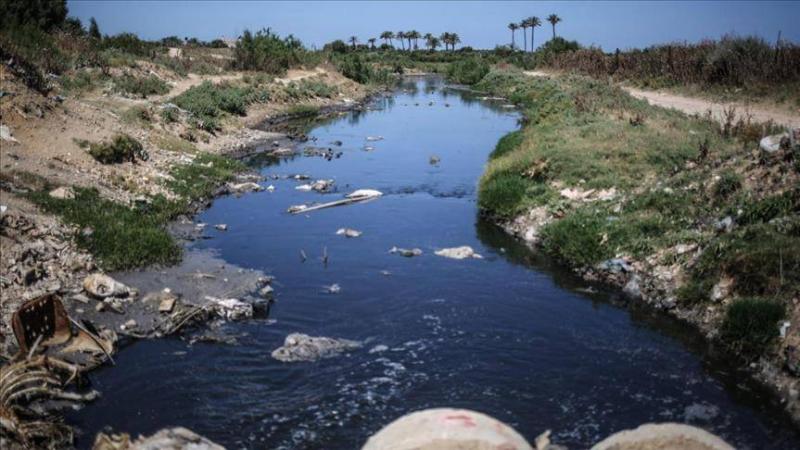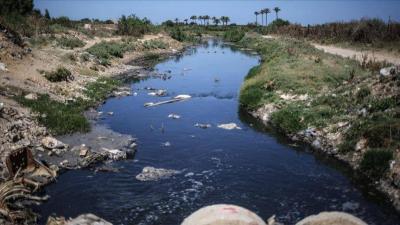Israel has previously succeeded in transforming Wadi Gaza into a "settlement" for rodents, snakes, and various diseases resulting from polluted water. Today, it is thrust back into the spotlight from the depths of neglect, but for the purpose of entering into a diaspora reminiscent of the Nakba of 1948. The flyers dropped on the residents of Gaza City, demanding they relocate within 24 hours to the valley, serve as an official announcement to enter a new geography and strategy similar to what that place has become—a prison and a dumping ground.
### What About the Valley?
Wadi Gaza (in Hebrew transliteration, Nahal Habesar) is a valley in southern Israel, part of historic Palestine. The course begins at Mount Shajarat al-Baqar (near the settlement of Sde Boker) and flows into the Mediterranean Sea near Al-Zahra in the Gaza Strip, hence the Arabic name Wadi Gaza. The upper portion is known as Wadi al-Shallala, as indicated in a map from the Western Palestine Survey published in 1878. Along the wadi, there are several significant archaeological sites. It is the largest valley in northern Negev, with its tributaries including Wadi al-Shari'ah (the largest of these tributaries) and the Beersheba River towards the east in the desert reaching Sde Boker, Yerocham, Dimona, and Arad. The coastal aquifer part located within the boundaries of the Gaza Strip is the only significant water source in the area. The wetlands through which the valley flows have been used as a sewer for untreated wastewater since 2012.
The width of the valley varies from 40 meters at its narrowest points to 400 meters along the western coast of the Gaza Strip. It geographically divides the Gaza Strip into two parts: northern and southern.
### The Southern Area
The southern area of the valley is home to dozens of Palestinian towns, neighborhoods, and camps, including Al-Nuseirat, Deir al-Balah, Al-Bureij, Al-Maghazi, Khan Younis, Abasan, and Rafah. In the area north of the valley, which has been ordered for evacuation, more than 1.1 million Palestinians live in several cities, refugee camps, and villages, including Gaza City, Jabalia, Jabalia Camp, Beit Lahia, Beit Hanoun, and Umm al-Nasr.
### A Waste Dump
Following the Palestinian Authority's declaration of the valley as a reserve in 1994, it became a waste dump for 16,000 cubic meters of untreated wastewater daily, inhabited by rodents, insects, and snakes, making it an uninhabitable pollution hotspot.
### A Pre-Planned Move
According to many local residents, plans to revive and pay attention to the valley began two years ago, indicating that Israel was gradually preparing for this relocation.
### The Old Valley
An environmental expert in the area presented the biodiversity and various overlapping environments in Wadi Gaza, which included saline environments from the sea water and coastal regions, sandy areas, wetlands, clay soils, and the vegetation that once thrived there. He noted that "more than 250 species of birds, in addition to 120 animal species, and over 140 bird species specifically migrated and moved to the valley to nest, crossing thousands of kilometers from different environments."
He added: "This mixture of fresh water from northern Palestine, the region of Samu, and the eastern Negev, which covers 3,500 square kilometers on its way to Gaza, collects rainwater throughout the winter, with over 25 million cubic meters of fresh water flowing through this valley that extends 9 kilometers across Gaza, nourishing the aquifer and enriching wildlife and the environment."
Continuing, he stated: "All of this made Wadi Gaza a unique natural reserve with educational, cultural, and environmental biological heritage, earning Wadi Gaza this good reputation." He explained that over the past years, due to the blockade, wars, and the reality in the Gaza Strip, thousands of cubic meters of wastewater have flowed into the sea daily, amounting to more than 23,000 cubic meters of raw sewage, destroying this natural environment and turning it into a hazardous area affecting its neighbors.
He noted that more than 6,000 residents living in seven areas surrounding the valley felt sorrow and pain, leading many to leave their homes due to the accumulated environmental pollution in Wadi Gaza.




